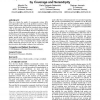Free Online Productivity Tools
i2Speak
i2Symbol
i2OCR
iTex2Img
iWeb2Print
iWeb2Shot
i2Type
iPdf2Split
iPdf2Merge
i2Bopomofo
i2Arabic
i2Style
i2Image
i2PDF
iLatex2Rtf
Sci2ools
RECSYS
2010
ACM
2010
ACM
Beyond accuracy: evaluating recommender systems by coverage and serendipity
When we evaluate the quality of recommender systems (RS), most approaches only focus on the predictive accuracy of these systems. Recent works suggest that beyond accuracy there is a variety of other metrics that should be considered when evaluating a RS. In this paper we focus on two crucial metrics in RS evaluation: coverage and serendipity. Based on a literature review, we first discuss both measurement methods as well as the tradeoff between good coverage and serendipity. We then analyze the role of coverage and serendipity as indicators of recommendation quality, present novel ways of how they can be measured and discuss how to interpret the obtained measurements. Overall, we argue that our new ways of measuring these concepts reflect the quality impression perceived by the user in a better way than previous metrics thus leading to enhanced user satisfaction. Categories and Subject Descriptors C.4 [Performance of Systems]: Measurement techniques. General Terms Measurement, Perfor...
| Added | 06 Dec 2010 |
| Updated | 06 Dec 2010 |
| Type | Conference |
| Year | 2010 |
| Where | RECSYS |
| Authors | Mouzhi Ge, Carla Delgado-Battenfeld, Dietmar Jannach |
Comments (0)

